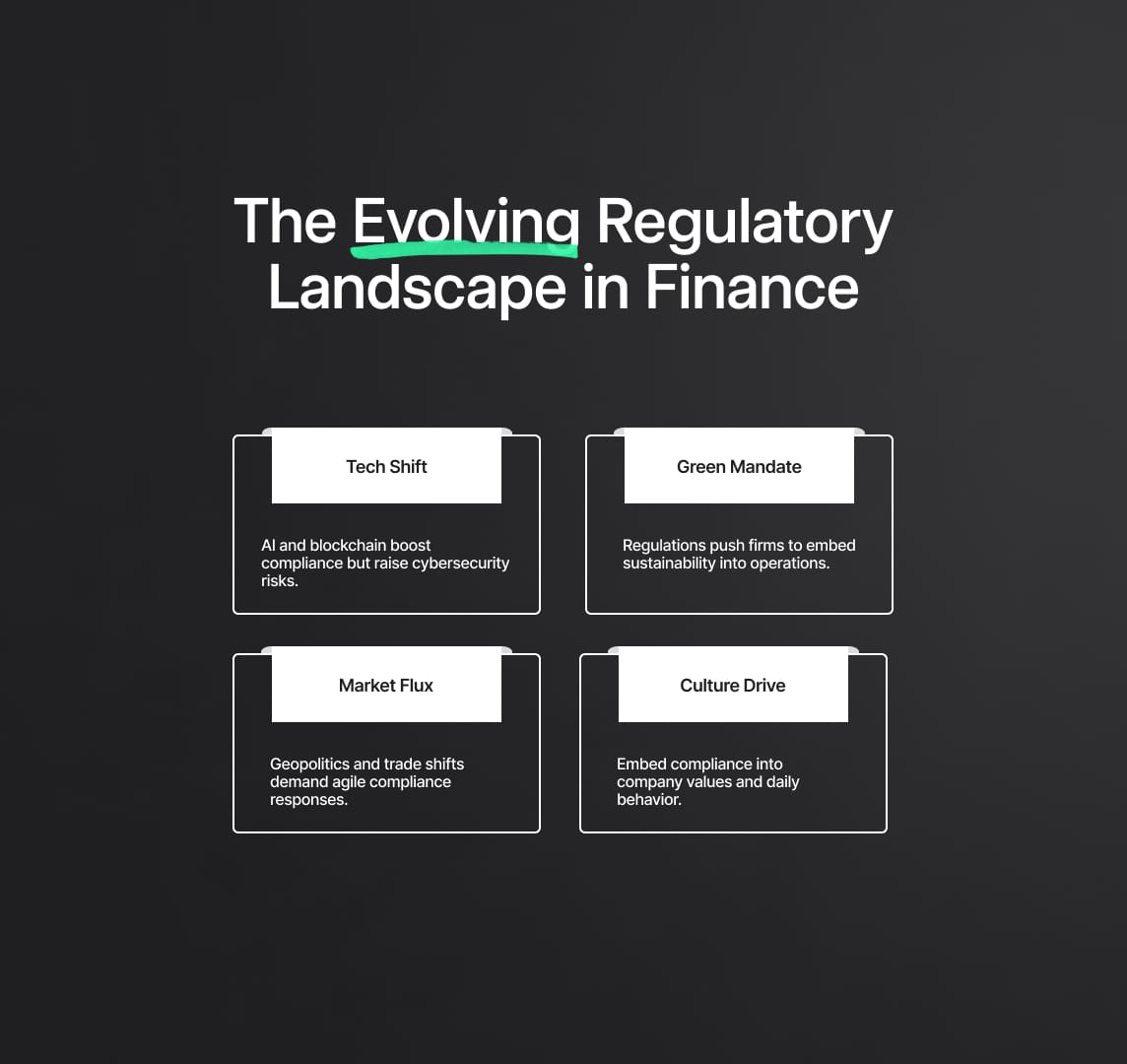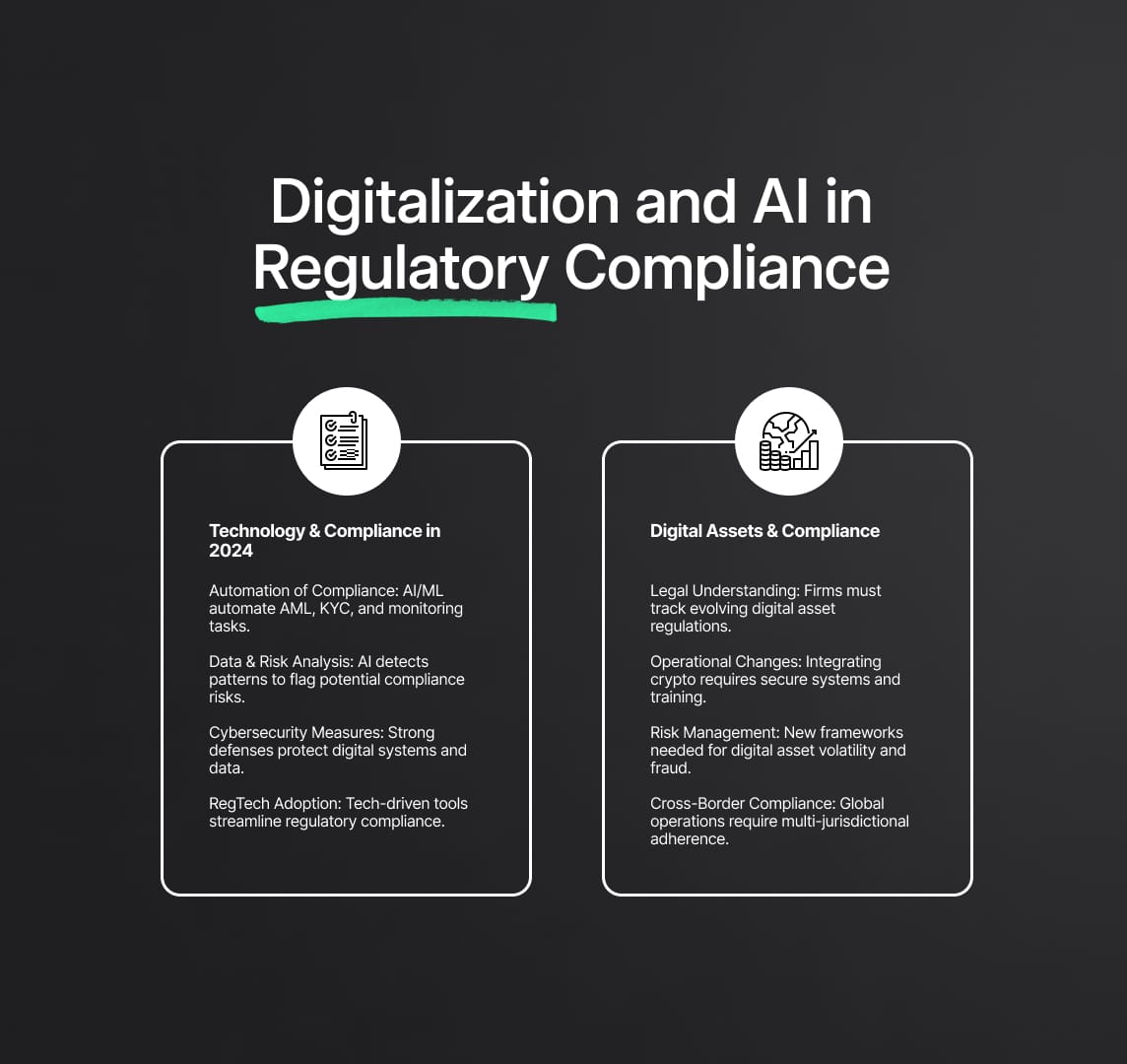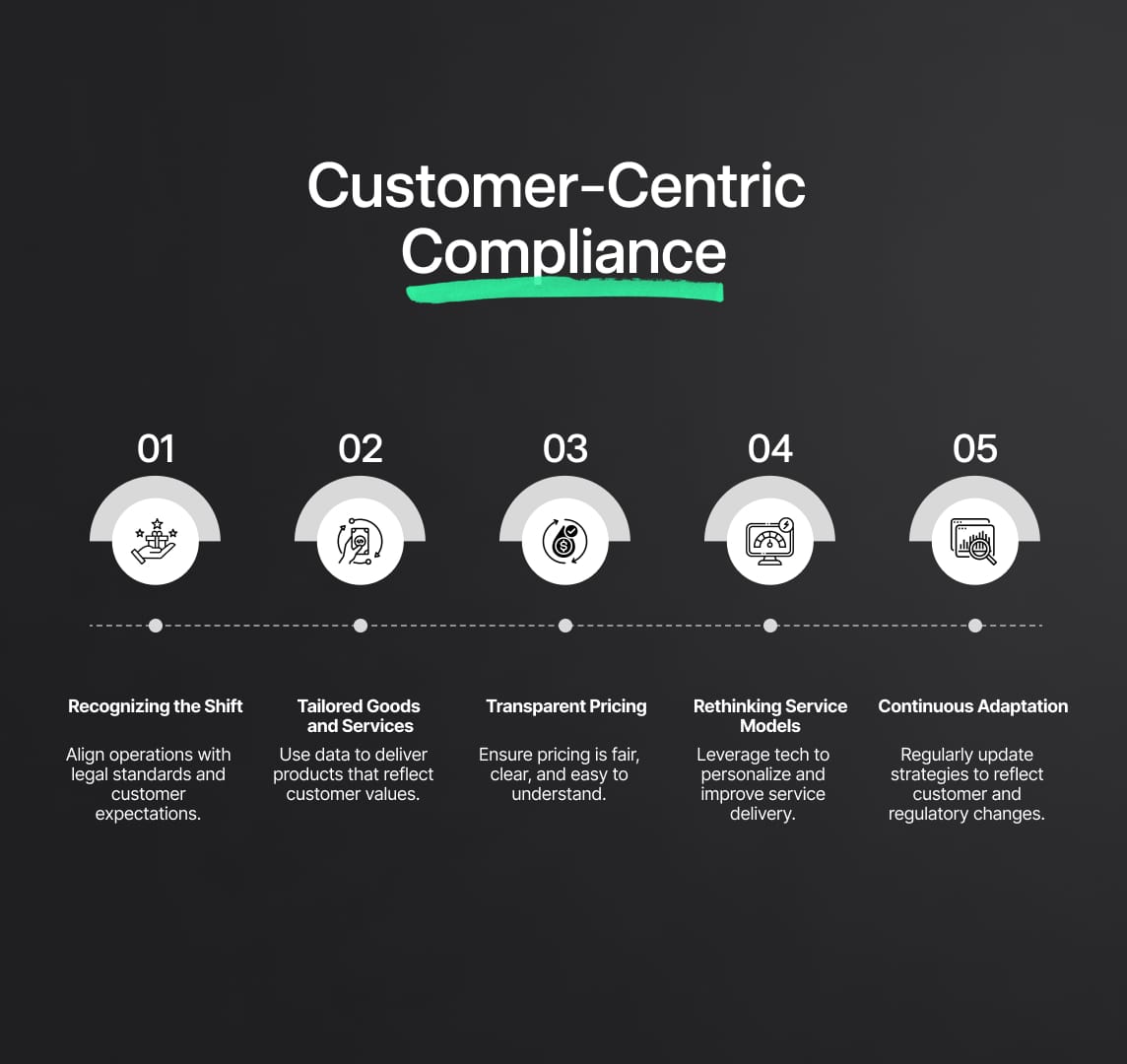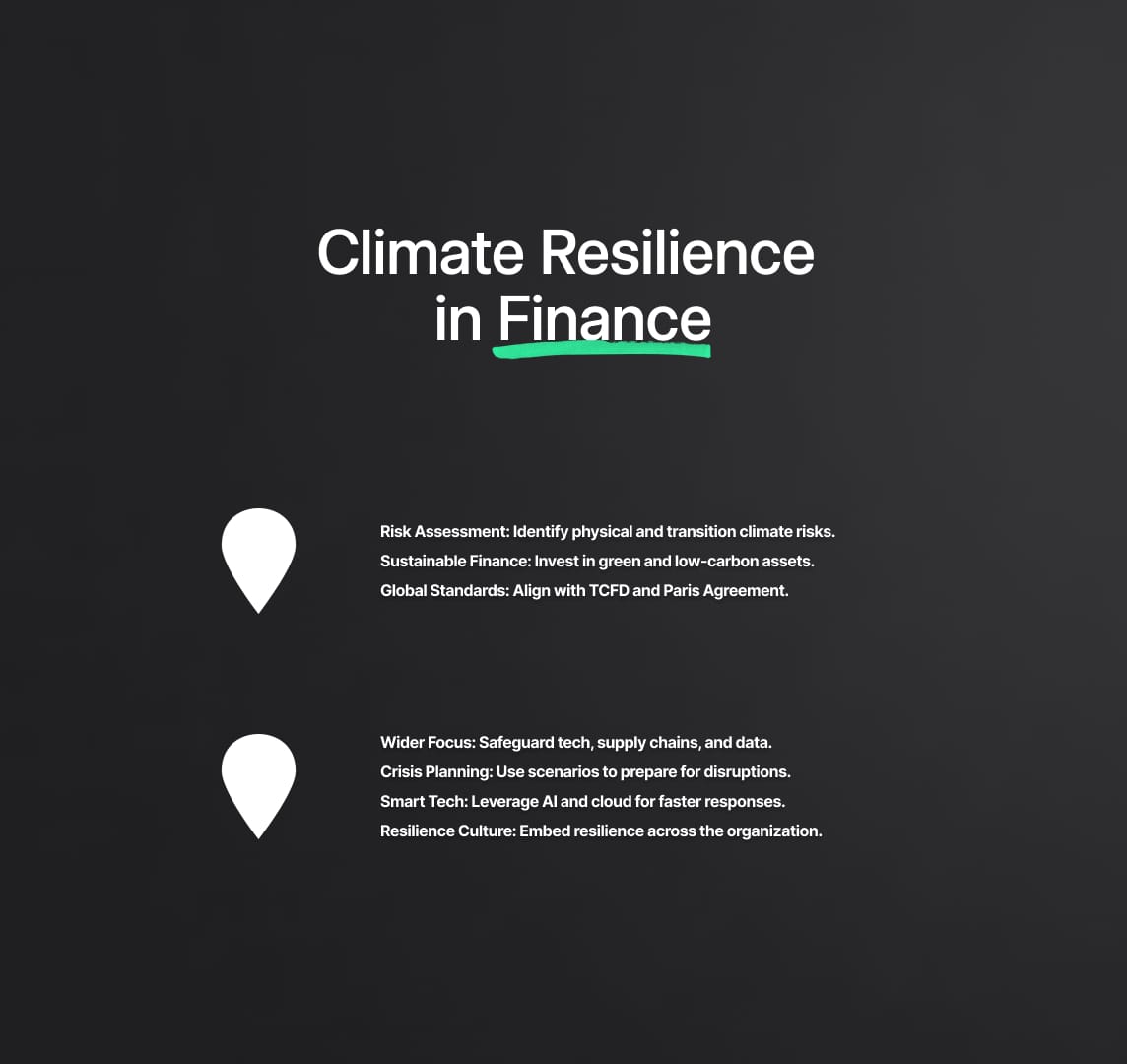Regulatory Risk and Compliance in 2024: An Extensive Guide
2024: Strategic approaches in regulatory risk and compliance, focusing on climate-related financial risks, operational resilience, ESG integration, and AI utilization. Essential for navigating complex regulatory landscapes, emphasizing sustainable practices and technological advancements.


1. The Evolving Regulatory Landscape in Business and Financial Services
Introduction to 2024's Regulatory Challenges
Businesses and financial services are at the vanguard of a transformative period characterized by enormous regulatory hurdles in the dynamic world of 2024. This complex environment necessitates a thorough understanding of regulatory risk and compliance since it is driven by the growth of technology, a growing commitment to environmental sustainability, and changeable global market dynamics. It takes more than just survival to navigate this terrain; you also need to know how to use these obstacles to your advantage to become more competitive.
Strategic Foresight and Agility
- Technological Advancements: New avenues for managing regulatory risk and compliance have been made possible by the digital revolution, which has been driven by revolutionary advancements in blockchain, artificial intelligence (AI), and machine learning. These technologies present hitherto unseen chances to improve compliance processes' accuracy and efficiency. They do, however, also bring with them new difficulties, especially in data protection and cybersecurity. In order for businesses to prosper in 2024, they will need to both adopt these technology advancements and effectively handle the risks that come with them. This entails making investments in strong cybersecurity defenses and making sure data privacy policies adhere to the most recent laws.
- Environmental Concerns: Environmental sustainability is a major focus of the modern period, and regulatory bodies everywhere are aggressively incorporating environmental considerations into their frameworks. Companies must integrate environmental responsibility into the very fabric of their operations, going beyond simple compliance. This change is being brought about not only by legal requirements but also by stakeholders' and customers' increasing expectations that businesses will show a sincere commitment to sustainability. In order to ensure that they meet regulatory requirements and make a positive contribution to environmental goals, businesses must match their plans and operations with sustainable practices.
- Market Dynamics: Economic changes, geopolitical conflicts, and changing trade policies will all have an impact on the volatility and unpredictability of the global market in 2024. To successfully traverse this landscape, businesses need to demonstrate an approach that is both flexible and responsive. Maintaining regulatory compliance and gaining a competitive edge in such a changing environment requires being knowledgeable, adaptable, and having the ability to sense and respond to changes in the market.
- Cultural Shift: Fostering an organizational culture that is compliance-centric is essential to managing regulatory risk and compliance successfully. This means making sure that compliance with regulations is ingrained in all facets of business operations by making it a core value. All staff members, including those in leadership positions, need to be aware of the significance of regulatory compliance and possess the necessary skills and information to act appropriately. This culture shift is essential to creating an atmosphere in which ethical business practices and organizational success are seen as entwined with compliance, rather than as a burden.
In 2024, navigating the changing regulatory environment in business and finance will necessitate a combination of environmental consciousness, technology know-how, market agility, and a deeply embedded compliance culture. Businesses who adopt these components will be able to use them as accelerators for innovation and growth in addition to successfully navigating regulatory obstacles.
2. Strategic Management of Regulatory Risks in 2024
Understanding regulatory risk management in 2024's changing business environment will not only be necessary, but also a competitive advantage. Companies must adopt a proactive and strategic strategy as they contend with a regulatory environment that is always changing.

Proactive Regulatory Risk Management
The regulatory landscape of 2024 is distinguished by its complexity and quick change. Businesses are realizing that it is no longer enough to just respond to changes. Rather, a proactive, forward-thinking strategy is needed, one that includes anticipating future legislative trends and movements in addition to adhering to current regulations.
- Predictive Compliance Strategies: Predictive compliance strategies are essential for negotiating this maze of ever changing laws. Companies need to spend money on technologies that predict future regulatory changes in addition to monitoring present compliance status. This entails modeling prospective regulatory changes and evaluating their effects using data analytics and artificial intelligence.
- Agile Frameworks: Businesses can quickly adjust to new laws and norms thanks to regulatory frameworks that are agile. It is crucial to create adaptable policies and processes that can swiftly take new regulatory needs into account.
- Engaging Stakeholders: Taking the initiative to interact with legislators and regulators might provide you early notice of impending changes. Additionally, there are chances to influence the creation of sensible and efficient regulatory regulations through this participation.

Integrating ESG Considerations
The increasing focus on sustainability has made it standard practice to incorporate ESG considerations into regulatory policies. This change reflects a broader realization that social responsibility, environmental stewardship, and strong governance are inextricably tied to long-term corporate success.
- Continuous ESG Evaluation: The process of incorporating ESG considerations is ongoing. Companies must constantly review and modify their procedures to make sure they comply with the most recent ESG guidelines as well as new developments in the industry. Comprehensive ESG audits and stakeholder feedback analysis are necessary for this.
- Sustainable Business Practices: Rethinking supplier chains, resource utilization, and corporate social responsibility programs are all part of aligning business operations with sustainability goals. It's about adding value that considers social and environmental effect in addition to financial achievement.
- Ethics and Governance: Robust governance frameworks are essential. This entails making sure that corporate operations are transparent and accountable and ingraining ethical decision-making at all organizational levels.

3. Technological and ESG Impact on Financial Institutions
Digitalization and AI in Regulatory Compliance
The importance of technology in maintaining regulatory compliance has grown in the age of digital transformation. In 2024, artificial intelligence (AI) and machine learning will be key technologies that financial institutions must navigate as they navigate a sea of technological breakthroughs. These innovations have the enormous potential to completely transform compliance procedures and improve their accuracy, efficiency, and security. But there are drawbacks to this digital transformation as well.
- Automation of Compliance: Artificial intelligence (AI) and machine learning algorithms can automate complicated compliance activities, lowering the risk of human error and boosting productivity. This entails keeping an eye out for any suspicious activity related to transactions, making sure that Anti-Money Laundering (AML) requirements are followed, and carrying out Know Your Customer (KYC) checks more successfully.
- Data Analysis and Risk Assessment: Artificial intelligence (AI) systems are capable of analyzing large volumes of data to spot patterns and trends that could point to legal risks. Financial organizations can be proactive in mitigating any compliance difficulties with this predictive analytics capability.
- Handling Cybersecurity Risks: As more and more data is handled digitally, cybersecurity is becoming a top priority. To safeguard confidential information and preserve the integrity of their digital systems, financial institutions need to bolster their cyber defenses. This entails using cutting-edge encryption technology, conducting routine security audits, and educating employees on cybersecurity best practices.
- Evolution of Regulatory Tech (RegTech): The regulatory landscape is changing due to the emergence of RegTech solutions, which use technology for regulatory monitoring, reporting, and compliance. These technologies give financial institutions quick, easy, and affordable options to comply with changing requirements.
Embracing Digital Assets
One major change in the financial landscape is the rise of digital assets, such tokenized securities and cryptocurrencies. For regulatory compliance, this new asset class presents a number of opportunities as well as difficulties.
- Comprehending the Legal Framework: The legal and regulatory landscape pertaining to digital assets is always changing as they become more widely accepted. Financial institutions need to keep up with these developments and be aware of how they may affect their compliance and operational plans.
- Operational Opportunities and Challenges: Rethinking conventional operational methods is necessary to integrate digital assets into financial services. This entails establishing safe channels for the exchange of digital assets, formulating fresh guidelines and protocols, and educating employees on how to manage these resources effectively.
- Risk Management Techniques: There are particular risks associated with digital assets, such as regulatory uncertainty, market volatility, and security issues. Financial institutions must create strong frameworks for risk management in order to take advantage of the benefits presented by digital assets and solve these issues.
- Cross-Border Compliance: Cross-border regulatory compliance is essential given the global nature of digital assets. Institutions have to manage the intricate network of global legislation and make sure that their operations involving digital assets abide by the laws of every country in which they conduct business.

4. Enhancing Compliance and Consumer-Centric Approaches
The corporate sector is witnessing a dramatic change towards a consumer-centric regulatory framework in the constantly changing landscape of 2024. This development involves more than just following the law; it also involves realigning corporate models and tactics to better meet the demands and expectations of customers. It shows that corporate success is contingent on both regulatory compliance and customer happiness, and that they are not mutually exclusive.
Consumer-Centric Regulatory Framework: Aligning Business with Consumer Interests
- Recognizing the Shift: The present regulatory landscape places equal emphasis on the effects that corporate operations have on customers as well as their legality. This change necessitates a greater comprehension of customer needs and the application of these understandings to corporate operations. It involves developing value propositions that satisfy customers and comply with legal requirements.
- Tailored Goods and Services: Contemporary customers expect goods and services that are not only of the highest caliber but also responsibly sourced, ecologically benign, and socially conscious. Companies need to collect customer feedback, conduct in-depth market research, and use data analytics to optimize their products. This method guarantees that goods and services are in line with customer preferences and values in addition to meeting legal requirements.
- Strategies for Transparent Pricing: Today, customer trust is based on price transparency. Companies need to make sure that their pricing strategies are clear, reasonable, and competitive. This entails outlining the value offered precisely, minimizing extra fees, and providing consumer-friendly explanations of pricing systems. Using honest pricing practices is essential to developing enduring relationships with customers.
- Rethinking Service Delivery Models: It's critical to reevaluate service delivery models in a time when customer experience can make a significant difference. This entails using technology to provide more individualized and effective services, guaranteeing prompt and helpful customer care, and customizing service delivery to satisfy the demands of various customer segments. Improved service delivery models show how dedicated a company is to meeting client needs and adhering to regulations.
- Constant Improvement and Adaptation: The consumer-centric approach is a continual process rather than a one-time event. Businesses must remain aware of evolving customer patterns, updated regulations, and improvements in technology. Updating tactics, educating employees, and streamlining processes are critical components of keeping a customer-focused and legal business model.
Creating a Synergy between Compliance and Consumer Satisfaction
To sum up, the goal of improving compliance and implementing consumer-centric strategies in 2024 is to establish a mutually beneficial relationship between regulatory compliance and customer happiness. By using an integrated approach, firms can develop a strong and devoted consumer base in addition to improving their regulatory standing. Businesses can contribute to a more prosperous, ethical, and sustainable future by putting the needs and expectations of their customers first, while adhering to the regulatory framework.

5. Addressing Climate-Related Financial Risks and Operational Resilience
Climate-Related Financial Risk Management
The management of financial risks associated with climate change is a critical concern for organizations globally in the dynamic landscape of 2024. This difficult endeavor calls for a diversified strategy:
- Carrying Out Comprehensive Climate Risk Assessments: Companies need to carry out comprehensive assessments to determine and assess the ways in which climate change affects their operations and financial stability. Analyzing direct risks, such as the effects of climate events on the body, as well as indirect risks, like policy changes and consumer preferences shifting in favor of sustainable goods and services, is part of this.
- Adopting Sustainable Financing and Investment Strategies: Businesses are urged to realign their financing and investment strategies with sustainable practices as the globe turns to a greener economy. This change entails looking at eco-friendly initiatives, green bonds, and other sustainable financial products that take advantage of the benefits brought about by the shift to a low-carbon economy while also reducing risk.
- Keeping Up with International Climate Standards and efforts: It is required of organizations to keep up with and adhere to international climate standards and efforts, such the Task Force on Climate-related Financial Disclosures (TCFD) and the Paris Agreement. Adhering to these guidelines improves stakeholder trust and corporate reputation in addition to guaranteeing regulatory compliance.
Operational Resilience and Crisis Management
In 2024, the idea of operational resilience underwent a substantial transformation and emerged as a crucial element of strategic planning:
- Extending the Ambit of Resilience: Financial stability is no longer the exclusive focus of operational resilience. It entails upholding the dependability of technology, protecting supply chains from interruption, and guaranteeing strong cybersecurity and data protection protocols. In the current era of widespread digital connectedness, protecting oneself from cyberattacks and technical malfunctions is crucial.
- All-encompassing Disruption Management Plans: Companies must have all-encompassing plans to deal with possible disruptions. This entails carrying out frequent risk assessments to find weak points and putting sophisticated scenario preparation into practice to be ready for a range of possible emergencies, including as cyberattacks and natural disasters.
- Leveraging Technology for Improved Resilience: Improving operational resilience mostly depends on the application of cutting-edge technology like artificial intelligence (AI), big data analytics, and cloud computing. With the use of these technologies, firms can anticipate problems and react to them more quickly, maintaining continuity and immediately reducing risks.
- Developing a Resilience Mindset: It's critical to create a culture that values resilience. This entails creating an environment within the company where each worker is aware of their responsibility for resilience and has the resources and expertise necessary to handle obstacles with grace.
Grand Answer: Your AI Partner
Designed to support compliance officers, legal counsels, and other professionals responsible for adhering to regulatory standards, Grand Answer aims to facilitate an efficient and straightforward compliance process.
Reduce your
compliance risks

